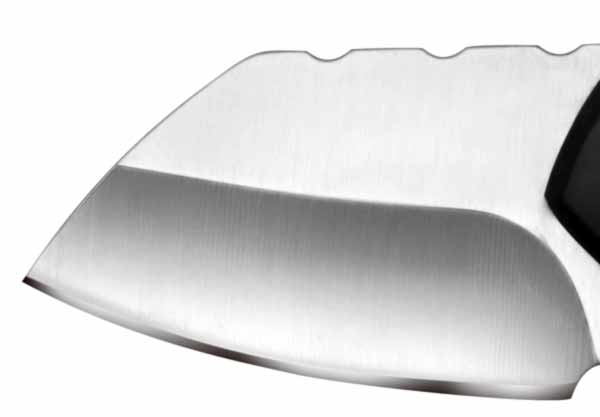The Sheepsfoot Blade: The Knife That Does The Safety Dance
The sheepsfoot blade is like the overly cautious uncle of the knife family. He’s a real straight shooter cutter, but instead of a pointy end, it sports a blunt, rounded tip, for those who want to cut stuff but not accidentally audition for a stabbing scene. This no-nonsense design makes the sheepsfoot blade the go-to choice for boaters and first responders. Imagine accidentally stabbing your pontoon!
Design Characteristics
The sheepsfoot blade features a straight edge with a spine curving downward to a rounded, blunt tip. This design results in a wide, flat blade with a low curve, ideal for controlled slicing. Perfect for slicing with precision: it’s like a ninja who’s also a softie.
Uses and Applications
Rescue and Emergency Services: The sheepsfoot blade is basically the superhero of rescue knives. Emergency responders love it because it can slice through seat a standard in the world of rescue knives. Capable of slicing belts, clothes, or ropes like child’s play (either the movie or the old saying) without turning anyone into an accidental pincushion, thanks to its blunt tip. This means faster rescues and hopefully, less blood.
All this talk about blunt tips and not one Cypress Hill joke? You really have matured, STRONK writer. I’m really proud of you/me..us?.
Whittling and Woodworking: The straight edge allows for detailed carving and precise cuts to shape and smooth wood.
Cooking: Some kitchen knives adopt the sheepsfoot design for tasks like chopping vegetables or slicing cheese.
Everyday Carry (EDC): Many EDC knives feature sheepsfoot blades for their balance of safety and functionality, because EDC guys around the world are known for their love of *checks notes* not stabbing themselves.
Advantages of the Sheepsfoot Blade
Holy cow, are we doing this again? I think they got the point. Unlike, you guessed it: the sheepsfoot blade.
Control and Versatility: The straight edge and low curve of the sheepsfoot blade offer excellent control for slicing and cutting tasks, making it suitable for a wide range of uses from emergency rescue to food preparation.
Durability: The thick spine and robust blade shape tend to be sturdy and less prone to chipping compared to more delicate pointed blades.
Conclusion
The sheepsfoot blade is a practical and safe blade design suited for tasks requiring precision and control without the risk of accidental punctures. Its popularity among rescue workers, woodworkers, chefs, and everyday users underscores its versatility and reliability. Whether you need a knife for emergency situations, detailed carving, or safe food preparation, a sheepsfoot blade offers an excellent blend of functionality and safety.

